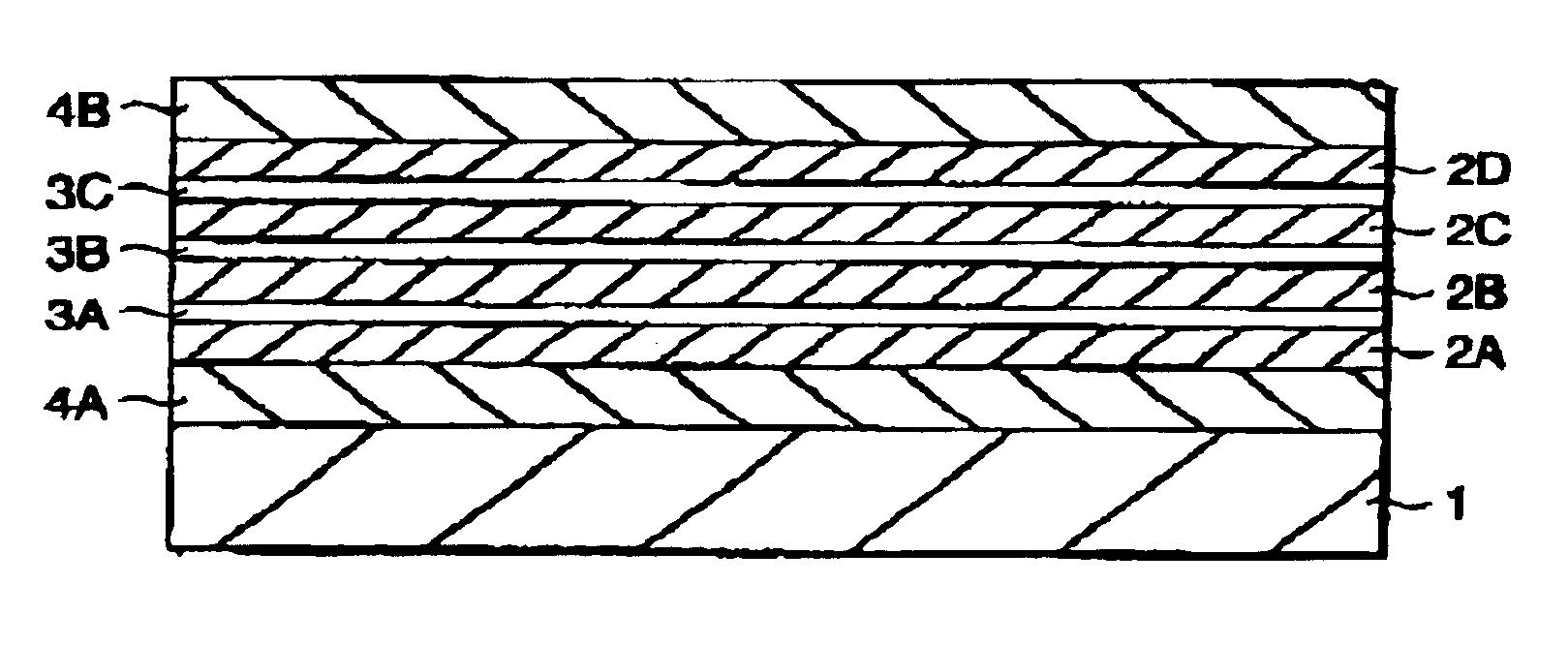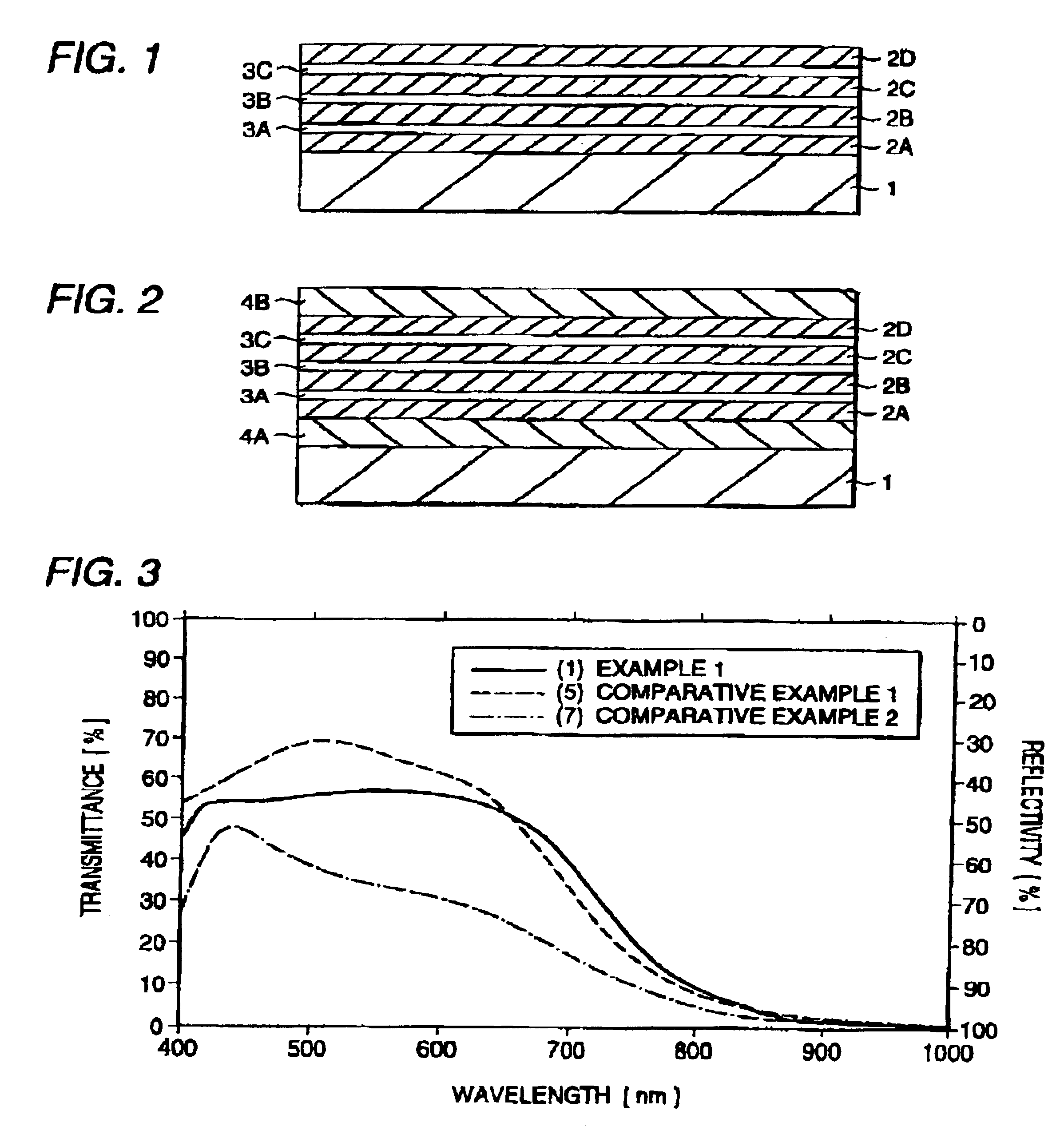Transparent laminate, method for producing the same, and plasma display panel
a technology of transparent laminate and plasma display panel, which is applied in the direction of identification means, instruments, lighting and heating apparatus, etc., can solve the problems of insufficient electromagnetic wave shielding function, difficult continuous structure, and reduced transmittance in a certain wave range, so as to achieve good visibility and reduce the effect of transmittance dependen
- Summary
- Abstract
- Description
- Claims
- Application Information
AI Technical Summary
Benefits of technology
Problems solved by technology
Method used
Image
Examples
example 1
Three thin-film units each unit consisting of a combination of a high-refractive-index transparent thin film and a silver transparent conductive thin film were deposited successively on one side of a 125 μm-thick transparent polyethylene terephthalate (hereinafter referred to as “PET”) film by a DC magnetron sputtering method. A high-refractive-index transparent thin film was further deposited on a surface of the laminate of the three thin-film units. Thus, a transparent laminate was produced by the aforementioned method. In this occasion, In2O3 containing 12.6% by weight of TiO2 (hereinafter abbreviated as “IT”) was used as a target material for depositing the high-refractive-index transparent thin films and Ag containing 5% by weight of Au (hereinafter abbreviated as “Ag”) was used as a target material for depositing the silver transparent conductive thin films.
Film thickness was controlled by use of the analytical curve of the deposition rate obtained on the basis of film thickne...
example 2
An SiO2 layer was deposited on a 125 μm-thick transparent PET film at room temperature by a vacuum vapor deposition method. The refractive index nL of SiO2 measured by an ellipsometer was 1. 45. The thickness of the SiO2 layer was set to be 95 nm. Three thin-film units each consisting of a combination of an IT thin film and an Ag thin film were deposited successively on a surface of the SiO2 layer in the same manner as in Example 1. An IT thin film was further deposited on a surface of the laminate of the three thin-film units. Thus, a transparent laminate was produced as a sample (9). The thicknesses of respective thin films were as shown in numerical values (unit: nm) put in the following parentheses. The roll temperature for depositing the IT thin films and the Ag thin films and the deposition rate of Ag were as follows.
Sample (9)
PET / SiO2(95) / IT(32.5) / Ag(13) / IT(65) / Ag(13) / IT(65) / Ag(13) / IT(32.5)
<Roll Temperature: 373 K, deposition rate of Ag: 1.8 nm / sec>
example 3
In the transparent laminate produced in Example 2, an SiO2 layer was deposited on a surface of the IT thin film located as the outermost layer at room temperature by a vacuum vapor deposition method so that the thickness of the SiO2 layer was set to be 190 nm. Thus, a transparent laminate was produced as a sample (10). The thicknesses of respective thin films were as shown in numerical values (unit: nm) put in the following parentheses.
Sample (10)
PET / SiO2(95) / IT(32.5) / Ag(13) / IT(65) / Ag(13) / IT(65) / Ag(13) / IT(32.5) / SiO2(190)
PUM
| Property | Measurement | Unit |
|---|---|---|
| thickness | aaaaa | aaaaa |
| thickness | aaaaa | aaaaa |
| thickness | aaaaa | aaaaa |
Abstract
Description
Claims
Application Information
 Login to View More
Login to View More - R&D
- Intellectual Property
- Life Sciences
- Materials
- Tech Scout
- Unparalleled Data Quality
- Higher Quality Content
- 60% Fewer Hallucinations
Browse by: Latest US Patents, China's latest patents, Technical Efficacy Thesaurus, Application Domain, Technology Topic, Popular Technical Reports.
© 2025 PatSnap. All rights reserved.Legal|Privacy policy|Modern Slavery Act Transparency Statement|Sitemap|About US| Contact US: help@patsnap.com


